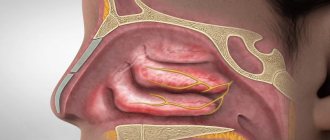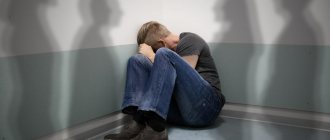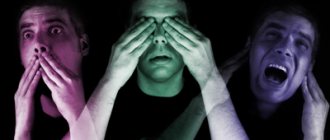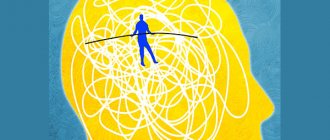Stages of disease development
The first signs of the disease appear in adolescence. This is isolation, isolation, reluctance to communicate with peers, and a depressive state. However, adults rarely pay attention to them, attributing them to the peculiarities and crises of this age period, so the disease can be recognized much later.
Experts identify several stages in the development of sluggish schizophrenia.
- The first, latent period. The symptoms are subtle and mild. At this time, the patient begins to show a tendency to philosophical reflection, thinks abstractly, and withdraws into himself.
- The second, manifest period. Signs of sluggish schizophrenia become more noticeable, their active manifestation is episodic. A person withdraws more into himself, he develops phobias, obsessions and fears, panic attacks, and sleep problems. The patient stops experiencing strong emotions and loses interest in his hobbies. It is at this stage that they usually “notice” the disease, turn to a psychiatrist, make an accurate diagnosis and begin treatment.
- The third stage is stabilization. People come to him as a result of a course of medication and psychotherapy. With favorable prognosis, the patient achieves a state of stable and long-term remission, continuing to take minimal doses of drugs to prevent relapse.
Forms of the disease
Sluggish schizophrenia comes in several types.
- The depersonalized form is a violation of self-perception of the individual and the boundaries of one’s own “I”.
- Neurosis-like – characterized by a weakening of the emotional sphere, apathy, dulling of feelings.
- Asthenic – expressed in rapid fatigue, a tendency to collect various objects.
- Obsessive – manifests itself in the presence of an obsessive state. The patient can perform the same action repeatedly and create rituals that only he understands.
- Hypochondriacal – develops against the background of changes in the patient’s hormonal levels, during adolescence, during pregnancy or menopause in women. A person is confident that he has a dangerous, sometimes fatal disease, and considers his state of health to be critical.
- Psychopathic - characterized by foolishness, an arrogant attitude towards others, delusions and hallucinations.
- Affective form - a person falls into a depressive state, analyzes his actions and actions, or experiences constant fluctuations from sharp enthusiasm to complete apathy. These extremes replace each other, each time causing a deterioration in the patient’s well-being.
- Latent form - the symptoms of sluggish schizophrenia are mild and do not progress to the active stage. This type of disease has the most positive treatment prognosis.
Neurohumoral therapy
In the forties of the twentieth century, it was believed that in the process of treating schizophrenia it is important to determine whether reactivity—cerebral or somatic (humoral)—plays a decisive role in the pathogenesis of this disease. It was assumed that in schizophrenia there is a certain parallelism between a decrease in cerebral reactivity and anergy of the humoral system, but the question of which of these processes was primary remained open. Some researchers believed that the specificity of the core of schizophrenia is caused by a decrease in the level of cerebral reactivity (Zalmanzon A.N., 1945).
They tried to treat schizophrenia by influencing skin receptors, based on the physiological role of the skin in the mechanisms of immunity and the occurrence of allergic reactions. Doctors had no doubt about the close connection of the skin with the nervous system, the role of nervous trophism in the process of neurohumoral interaction, and the cerebral mechanism of physiotherapeutic procedures. The use of skin irritations in the treatment of schizophrenia was led by studies concerning remissions during the disease in subcutaneous and skin inflammatory processes, as well as attempts to treat schizophrenia with turpentine abscesses (Zalmanzon A.N., 1945).
M.Ya. Sereisky emphasized the cerebral effect of active treatment methods and their effect on brain metabolism. Some authors have suggested that in many cases, changes in cerebral metabolism are a secondary result of the shock blocking effect on the central nervous system.
A.S. Kronfeld, in his doctrine of “anatax,” stated the unity of active methods of treating schizophrenia, based on the activation of nonspecific immunity. At the same time, changes in the whole organism were associated with cerebral processes, as if “dissolving in a single circle of biological changes.” It has been suggested that the biological restructuring of the body in schizophrenia is manifested in a “vital shift with a change in the sensorimotor set” - the basis of complex psychopathological changes. This whole process A.S. Kronfeld called “anatax,” which, in his opinion, was a fatally moving process of circular motion without a main link and driving force.
Partially, hyperbaric oxygenation can be attributed to therapy that affects metabolic processes and the reactivity of the body. The positive effects of hyperbaric oxygenation in schizophrenia were noted by N.M. Zharikov et al. (1981).
Features of signs of sluggish schizophrenia
This type of mental disorder is characterized by the manifestation of two typical signs of behavior change.
- Foolishness, clowning, eccentricity, awkward and unkempt appearance. The man looks like an eccentric - he is not dressed for the weather, he moves uncertainly, his movements are clumsy and angular. Speech disturbances also occur. It becomes saturated with complex phrases, thoughts become ragged and devoid of logic. You can often observe an abrupt transition from one topic to another.
- Pseudopsychopathization . It is expressed by increased emotional excitability and the presence of overvalued ideas. The patient is not able to perceive criticism addressed to him and adequately evaluate his actions.
If you notice strange behavior in a loved one, it’s time to sound the alarm and take action. Call the “Balance” clinic by phone: +7 (499)495-45-03 . We will answer all your questions, advise you on what to do, and, if necessary, fill out an application for a doctor to be called to your home at any time of the day.
Symptoms and signs of low-grade schizophrenia
A feature of this type of mental disorder is the absence of pronounced productive and negative symptoms. The patient is not very different from normal, healthy people, and is able to lead a socially active life. Although the symptoms of the disease do not lead to personality degradation, they affect changes and deformation of behavior, thinking, areas of interest and manner of communication.
There are 7 symptoms of low-grade schizophrenia.
- Depersonalization . The patient is satisfied with his own “I”, as well as the ability to express his opinions, thoughts and feelings.
- Finding flaws in your appearance. A person is critical of himself, dissatisfied with his appearance, weight, and can lead himself to anorexia.
- Hysterical state. It is typical mainly for women. Through hysterics and tears, the patient tries to attract attention to himself.
- Solitude, isolation. A person does not want to go out, communicate with peers and immediate surroundings. The extreme manifestation of this symptom is the development of autism.
- Aggressive and affective behavior , uncontrollable outbursts of anger and irritability.
- Dulling of feelings , loss of the ability to empathize, disturbance of the emotional sphere.
- Demonstrative behavior , arrogant attitude towards others, unfounded criticism of them.
Such alarming symptoms should at least concern relatives and force them to consult a specialist. You can call our “Balance” clinic by phone: . We will make an appointment with an experienced psychiatrist. Or make an appointment yourself.
Sleep therapy
In 1920, Swiss doctors R. Klaesi et al. proposed treating schizophrenia with narcotic sleep. It was assumed that sleep treatment breaks the vicious circle “formed by motor excitation, the growth of this excitation due to the resulting irritation of internal receptors.”
The theoretical justification for treatment with prolonged sleep was the idea of an artificially induced disease, the result of which would be the need for help and support. It was assumed that in this case the patient becomes available to psychotherapy due to his helplessness.
Treatment with narcotic sleep was far from a safe method of therapy. In addition, it turned out to be ineffective, since after the patient woke up, the excitement resumed again.
In 1935-1936 in the laboratory of I.P. Pavlova was the first to use long-sleep treatment by A.G. Ivanov-Smolensky.
In the 30s of the twentieth century V.A. Gilyarovsky also proposed treating schizophrenia with long-term sleep using anesthesia. Employees of the psychiatric clinic of the Moscow Medical Institute in 1936-1938. for this purpose they used the so-called Cloette mixture and, somewhat later, amytal sodium. At the same time, we were talking not only about a medicinal method of treating schizophrenia, but also about a method of mental analysis, similar to the pharmacodynamic psychoanalysis that C. Paskal (1931) previously wrote about. V.A. Gilyarovsky believed that, to some extent, treatment with long-term anesthesia is the antipode to the infectious or intoxication process, according to the views of that time, which was considered an etiological factor in the development of schizophrenia. The author emphasized the speed of the recovery process after a long narcotic sleep, after the patients restored their physical condition. Good results of treatment with prolonged sleep were achieved if the disease began to be treated during the first two years, when pronounced negative symptoms had not yet had time to develop.
The best results in the treatment of long-term sleep were obtained in the presence of catatonia, hallucinations and delusions in the clinical picture, and particular effectiveness was noted in the treatment of paranoid syndrome.
M.Ya. Sereisky, who in his early works advocated the treatment of schizophrenia with prolonged sleep, noted that this type of therapy is more effective for the circular and sluggish form of schizophrenia than for protracted unfavorable forms of the disease. His students proposed treating schizophrenia with small doses of sleeping pills, which would not cause manifestations of toxicosis . One of the pioneers of domestic psychopharmacology G.Ya. Avrutsky proved the effectiveness of such therapy using a large amount of material.
Employees of M.Ya. Sereisky, L.P. Lobov and T.E. Romel wrote about the positive effect of a combination of sleeping pills, oxygen and multivitamins during an exacerbation of sluggish schizophrenia. The authors noted a particularly noticeable effect of such therapy in asthenic and depressive syndromes, as well as in the initial stages of schizophrenia, mainly manifested by neurotic symptoms. However, in this case it was most likely not about schizophrenia.
I.V. Strelchuk, in the treatment of schizophrenia, recommended long-term (18-20 hours a day) sleep, maintained at the level of deep natural sleep for 6-10 days.
Difficulties in diagnosis
Due to the slow progression and mild severity of symptoms, the diagnosis of “sluggish schizophrenia” is made already at the active stage of the disease. The complexity is also caused by the similarity of the symptoms of schizophrenia with a neurotic disorder. Only an experienced doctor is able to draw a clear line between these diseases and confidently make a diagnosis.
A psychiatrist at our clinic will conduct a detailed medical history, talk with the patient and his relatives, identify signs of low-grade schizophrenia, conduct laboratory tests and neuropsychological tests. Depending on the results of the study and classification of the form of mental disorder, an individual course of therapy will be selected.
Help with diagnostics
Pay attention to several characteristic signs that accompany the disease at the beginning of its onset. Perhaps they will help to recognize the disease in time:
- Social withdrawal. The person loses contact with loved ones. He tries to avoid meeting people, which is why he does not go to school or work. He becomes indifferent to previously loved things and hobbies.
- Personal hygiene. Problems with hygiene begin with the patient performing all procedures very slowly, gradually this interval increases even more. And over time, he generally stops brushing his teeth, washing himself, etc.
- Obsession with the supernatural. A person becomes overly interested in mysticism, extrasensory perception, and most often religion. Religious hallucinations are possible. Most likely, this is due to a break with reality.
- Sudden sharpness and activity in movements and facial expressions.
- Auditory hallucinations.
These symptoms are almost always present at the beginning of the development of schizophrenia and are important indicators of its occurrence.
Treatment of the disease
Sluggish schizophrenia is the mildest type of this type of mental disorder, so its treatment and achievement of a state of remission requires smaller dosages of medications. The doctor prescribes atypical antipsychotics, nootropics, antidepressants and tranquilizers to the patient. At your request, if there are no obvious signs for hospitalization, we can conduct a course of drug therapy in a hospital setting. We have all the conditions for this - comfortable and bright VIP category rooms, without sharing, 2 and 3 beds. After discharge from the hospital, treatment can be continued on an outpatient basis.
During the rehabilitation period, it will be necessary to continue taking medications, but in minimal doses. To prevent the risk of relapse, we recommend regularly visiting a doctor at our clinic and following all his recommendations. We provide treatment on an anonymous basis. After discharge, our patient will be able to return to an active social life without fear of disclosure and condemnation from others.
You can get advice and ask any questions that concern you by calling: +7
Diagnosis and treatment
During the initial diagnosis, the doctor examines the patient and talks with him. After this, relatives can be interviewed. The psychiatrist must see the picture from different sides, and not just from the words of the patient, who may be inadequate during an exacerbation. It is also necessary to find out whether a person has a genetic predisposition to such disorders. To do this, it is determined whether there were schizophrenics and mentally ill people in the family.
Diagnostics includes standard laboratory and instrumental procedures, including MRI, CT, EEG, tests, etc. Various psychotherapeutic tests are also prescribed. To make an accurate diagnosis, you need to differentiate it from similar disorders. This may require more than one month of observation of the patient.
Treatment is based on psycho- and drug therapy. The patient comes to individual and group sessions with a psychiatrist and also takes antipsychotic medications. The dosage and type of medicine are determined by the patient's condition. Atypical antipsychotics are usually prescribed. Relatives of the patient also come for consultation with a psychotherapist, who will have to learn how to interact with a schizophrenic.










